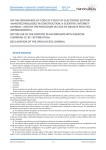Nanotechnologies in Construction: A Scientific Internet-Journal @nanobuild-en
Статьи журнала - Nanotechnologies in Construction: A Scientific Internet-Journal
Все статьи: 572
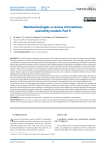
Nanotechnologies: a review of inventions and utility models. Part V
Статья научная
The article provides an abstract review of patents. The results of creative activity of scientists, engineers and specialists, including inventions in the field of nanotechnology and nanomaterials, being implemented, allow achieving a significant effect in construction, housing and community services, and related sectors of the economy. For example, the invention «A method to produce dry construction mixtures» refers to manufacturing of building materials, in particularly, to manufacture of dry construction mixtures (DCM) by the method of joint mechanoactivation of cement and dolomite, with further modification of them with carbon nanostructures (CNT). The technical result of the given method of mixing CNT and main component of dry construction mixtures - cement – is that it makes possible to use microquantities (0.005%) of CNT in DCM. That allows decreasing product cost of obtained mixture. Moreover, due to increased strength, faster hardening of materials one can reduce consumption of these mixtures. That is additional factor affecting decrease of mixture product cost. The results obtained after application of mechanoactivation of basic mixture components were different practically by all indicators from the mixtures prepared by simple mixing. Compression strength and tensile strength increased by 10–15%, adhesion strength increased too. Along with increasing of strength characteristics such an important indicator of DCM as air permeability has decreased. Reduction of total volume of pores in dense structure of cement matrix caused dramatic slow-up of moisture diffusion rate. The specialists can also be interested in the following inventions in the area of nanotechnologies: a method of laser building-up welding for metal coatings, high RAP in WMA surface mixture containing nanoglass fibers, a device to apply nanoparticles of metal oxides on metal surface under normal conditions, multifunctional nanostructured additive for coatings, experimental assessment of cement mortar using nanooxide compounds, a composition for setting constructional layers of road pavements, a method to obtain composite films of nanofibers, nano-engineering of construction materials using molecular dynamics simulations, cast and self-compacting concrete mixture for cast-in-situ concrete and prefabricated reinforced units, a method to obtain photocatalyst based on nanotubular titanium dioxide et al.
Бесплатно
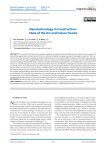
Nanotechnology in Construction: State of the Art and Future Trends
Статья научная
The construction industry has long been regarded asenergy-intensive and high pollution industry. The emergence of nanotechnology provides an ideal solution for the construction industry to energy saving and consumption reduction. The introduction of nanotechnology has greatly promoted the development of new green building materials and brought huge economic and social benefits. This paper applies bibliometric analysis to review the nanotechnology-construction research collected by Web of Science database during 2000–2020, and further visualize their literature characteristics. At the global level, the number of literatures on nanotechnology-construction research has been on the rise in 2000-2019, although it has experienced a small decline in individual years. At the national level, the United States has become the global leader in nanotechnology-construction research with 63 articles, far more than other countries. Considering the income gap, developed countries play an indispensable role in the global nanotechnology-construction research system, while the role of developing countries is relatively weak. We found that the existing nanotechnology-construction research mainly focused on the fields of chemistry and materials science. According to the frequency of keywords, the research focus of nanotechnology-construction research mainly focused on the development and application of new building materials. It is concluded that with the extensive attention of researchers, the future research on nanotechnology-construction will continue to appear and increase at increasing rate.
Бесплатно

Статья научная
Introduction. Currently, both abroad and in Russia, there is a “general digitalization” not only of certain types of activities, but also of objects of the technosphere, for example, “smart houses”, “safe cities”, etc. However, the “creators” of these objects violated the main principle of automation of Academician V.M. Glushkov, which says: you cannot automate the mess! Therefore, the authors of this article made an attempt to “eliminate clutter” in the automation of engineering systems in the residential sector. Methods, models and tools. Based on the analysis of the engineering systems of multi-apartment residential buildings and individual residential buildings, as a result of the functioning of which not only the delivery of “life support benefits” is carried out, but also fire-energy and environmental damage occurs, a methodology for “intellectualization” of the accounting means for the supplied resources has been developed for diagnostics and suppression of fire and energy harm with the help of modern nanotechnology and, thus, prevention of fires and explosions in the residential sector. Results and discussion. The methodology of “intellectualization” is based on the results of a system analysis of the “functioning of the residential sector” (apartment buildings and individual residential buildings), which made it possible to “discover” the dialectical unity of benefits and harms from consumed energy resources (electricity, domestic gas, hot and cold water), as well as to carry out a systemic synthesis of nanotechnologies and means of “isolation and suppression” of fire and energy harm. The novelty of the research is protected by RF patents. Conclusion. The proposed approach allows “eliminating the disorder before the automation” of engineering systems of multiapartment residential buildings and individual residential buildings, by “intellectualizing” metering devices and optimizing nanotechnologies for suppressing fire and energy harm that brings socio-economic losses.
Бесплатно
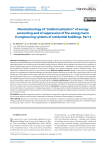
Статья научная
Introduction. At present, both abroad and in Russia, accidents, fires and explosions in the engineering systems of multiapartment residential buildings and individual residential buildings have become more frequent. At the same time, the "creators" of automated systems for monitoring and accounting of energy resources (ASKUE) did not attend to the solution of the problems of safety of engineering systems, since their goals were exclusively commercial tasks – "digitalization" of energy consumption metering and detection of illegal consumption of such sources. Therefore, in this article, an attempt is made to "eliminate clutter" in the automation of engineering systems in the residential sector. Methods, models and tools. Based on the analysis of engineering systems of multi-apartment residential buildings and individual residential buildings, as a result of the functioning of which not only the delivery of life support resources (gas, cold and hot water, electricity, communications, etc.) is carried out, but also fire-energy and environmental harm occurs, a methodology has been developed for the "intellectualization" of the means of accounting for the supplied resources, for the purpose of diagnosing and suppressing fire-energy harm using modern nanotechnologies and, thus, preventing accidents, explosions and fires in the residential sector. Results and discussion. The methodology of "intellectualization" is based on the dialectical unity of benefits and harms from consumed energy resources (electricity, domestic gas, hot and cold water), as well as to carry out a systemic synthesis of nanotechnologies and means of "detection and suppression" of fire-energy harm. The novelty of the research is protected by RF patents. Conclusion. The proposed approach makes it possible to "eliminate the disorder before the automation" of engineering systems of multi-apartment residential buildings and individual residential houses, by "intellectualizing" metering devices and optimizing nanotechnologies for suppressing fire-energy harm which leads to socio-economic losses.
Бесплатно
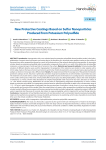
New Protective Coatings Based on Sulfur Nanoparticles Produced from Potassium Polysulfide
Статья научная
Introduction. Impregnation with a new solution based on potassium polysulfide showed excellent results in the hydrophobization of cement stone and cement-sand mortar due to the formation of a nanoscale water-repellent coating on the surface of the pores from sulfur nanoparticles formed as a result of the destruction of the molecule during the drying process. An innovative solution based on potassium polysulfide refers to polysulfur compounds, from which, as a result of the destruction of polysulfide molecules, a nanoscale layer of sulfur particles is formed on the surface. Materials and research methods. Potassium polysulfide solutions of different densities were used for impregnation; the properties of the solutions were tested on cubic samples with a 40 mm edge, made on the basis of cement and cement-sand mortar. Particle characteristics were evaluated using a laser particle size analyzer, an electron microscope and a diffractometer. Results. The analysis showed that the average size of the particles forming the protective coating is 20 nm, they have a spherically symmetric shape and crystallize into an orthorhombic crystal lattice structure. The treatment of concrete with a solution of potassium polysulfide ensures the formation of a coating based on nanosized sulfur on the surface of the pores of the stone, which partially fills the pore space and, being hydrophobic, reduces the water absorption of samples by 2–3 times, and the water absorption of samples impregnated under vacuum for 0.5 hours, decreases to values of 1.3–1.9%. Results and discussion. Modification of concrete with an impregnating composition developed by us with a solution based on potassium polysulfide The impregnating solution based on potassium polysulfide is stable in the concentration range of 1.15–1.35 g/cm3; upon impregnation, it penetrates into the pore structure of concrete at a level of up to 4 cm or more, depending on the growth and structure of the sample. When the material dries in its pores, sulfur nanoparticles crystallize from the polysulfide solution, partially filling the pore space and forming a protective durable insoluble hydrophobic coating that makes it difficult for water to penetrate into the pores of concrete, but retains its vapor permeability, which is important for wall and facing materials. Conclusions. Impregnation of road building materials and concrete products with a composition based on potassium polysulfide improves their performance properties, increases durability and resistance to weathering, which makes it possible to recommend it for use in the climatic conditions of the Russian Federation.
Бесплатно
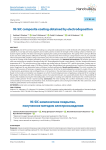
Ni-SiC composite coating obtained by electrodeposition
Статья научная
Introduction. One of the common types of coatings is a composite coating based on nickel reinforced with solid particles of silicon carbide SiC. It has high anti-wear properties and is widely used to increase the strength of the working surfaces of internal combustion engine cylinders. The basic technology for applying the coating is electrodeposition. The quality of the coating is affected by the size of the solid particles. Difficulties in forming a composite arise when moving to a large fraction of 20–25 μm, especially when moving from flat samples to long axisymmetric parts. The aim of the research is to study the technological potential of creating a Ni-SiC coating on flat samples simulating a sector of an axisymmetric part. Methods and materials. The research part of the work was carried out on samples of aluminum alloy AK7. Electrodeposition mode: current density 10 A/dm2; duration 60 minutes; temperature 60 °С. The microstructure of the coatings was studied using an Olympus GX51 optical microscope. Coating wear resistance tests were performed using a CSM Micro-Scratch Tester. Microhardness was assessed using a DuraScan 50 microhardness tester. Roughness Ra was determined using a Mitutoyo Surftest profilometer. Results and discussion. The article considers the features of the process of forming a composite coating based on Ni-SiC by the electrodeposition method. A model of the action of electrostatic, gravitational and centrifugal forces on SiC particles in the electrolyte solution for electrodeposition is presented. Based on the model, an installation was designed, on which the technological process of applying a composite Ni-SiC coating to flat samples of aluminum alloy AK7, simulating a sector of an axisymmetric part, was successfully tested. Due to the possibility of rotating the installation during the electrodeposition, three types of coating were obtained: nickel-based «Ni»; nickel-based with silicon carbide particles ”Ni-SiC”; layered coating. Conclusion. The nickel coating with a uniform distribution of SiC particles is characterized by the maximum microhardness value, increased roughness and a small groove width after the scratch test, which indicates good adhesion to the substrate material.
Бесплатно
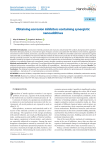
Obtaining corrosion inhibitors containing synergistic nanoadditives
Статья научная
Introduction. Construction materials, products and structures, and primarily their surfaces, during long-term operation have been destroying mainly as a result of two types of impact: corrosive, associated with the influence of an external, aggressive environment on the material, and erosive, caused by mechanical action. An effective and widely used means of protection against corrosion is the use of inhibitors The search for effective methods of anticorrosion protection of metals and alloys is due to the great damage caused by corrosion, not only in technological or economic terms. No less dangerous is the deterioration of the ecological situation caused by the ingress of corrosion products or toxic reagents into the environment. The leading place among corrosion inhibitors is occupied by heterocyclic compounds, namely, nitrogen-containing compounds, in particular imidazoline derivatives. Methods and materials. We synthesized 2-amylidenehydrazinoimidazolinone-4n aminoguanidine, on the basis of which we obtained anticorrosion compositions with the addition of nanoadditives – derivatives of unsymmetrical triazines. Results. The synthesized anticorrosive compositions were tested by electrochemical and gravimetric methods in acidic and model environments. Conclusion. The obtained compounds have a protective ability, and the results indicate the promising use of compositions with nanoadditives – derivatives of 1,2,4-aminotriazines as corrosion inhibitors.
Бесплатно
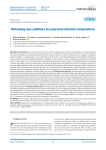
Obtaining new additives for polyvinyl chloride compositions
Статья научная
Introduction. Polyvinyl chloride (PVC) is the world's leading synthetic polymer in industrial use. Products based on PVC have firmly taken on the world market, and currently there is no highly developed country that is able to avoid its production and consumption. The high demand for thermoplastics is primarily due to its unique properties such as durability, resistance to climatic conditions, low flammability, good barrier properties, economy, environmental friendliness and versatility. The complex of technological and service properties of soft PVC, in addition to other additives, is mainly provided by plasticizers, the content of which can reach 50% or more. It is the efficiency of the plasticizing that has a decisive impact on the characteristics in the resulting materials and products. One of the most widely used classes of compounds in the plasticization of PVC are phthalic acid esters, in particular, dibutyl phthalate (DBP), di-(2-ethylhexyl)-phthalate (dioctyl phthalate, DOP), diisononyl phthalate (DINP) and diisodecyl phthalate (DIDP). Phthalates have found the greatest use as plasticizers due to their properties: good compatibility with PVC, low migration from plastic compound, minimal interaction with the polymer at room temperature, good frost resistance, high electrical insulating properties, availability, manufacturability and low cost. Methods and materials. The paper presents methods for the obtaining of novel symmetrical and asymmetric phthalate plasticizers: dibenzoxyethyl phthalates, benzylbenzoxyethyl phthalates, phenoxyethylbenzoxyethyl phthalates, ethoxyoctylbenzoxyethyl phthalates – by catalytic esterification of phthalic anhydride with oxyethylated phenylcarbinols, phenols and 2-ethylhexanols. The conditions for the synthesis of target products with the maximum yield were selected. The physicochemical properties of the obtained compounds were studied. The obtained experimental data were used to identify promising novel plasticizers of the phthalate type by cluster analysis. Cluster analysis for decision making is the most effective, as it is designed to combine some samples into classes (clusters) in such a way that the most similar in properties get into one cluster, but at the same time, samples of different clusters differ from each other as much as possible. Clustering carried out in the program Statistica 10. Results and discussion. According to the data obtained, it is found that benzylbenzoxyethyl phthalates and ethoxyoctylbenzoxyethyl phthalates have the best characteristics in terms of plasticizing ability. We study the influence of the selected plasticizers on the physical and mechanical characteristics of PVC compositions The effectiveness of compounds in the PVC composition is evaluated in terms of “elongation stress” and “breaking stress”. The test results of the samples are compared with the indicators of PVC compounds containing DBP. Conclusion. The use of the developed additives contributes to the production of PVC compounds with improved physical and mechanical characteristics.
Бесплатно
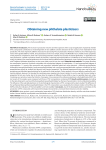
Obtaining new phthalate plasticizers
Статья научная
Introduction. The increase in production volumes and the expansion of the scope of application of polyvinyl chloride (PVC) compounds contributes to the development of new additives and the attraction of new sources of raw materials for their production. The most important additives necessary for processing PVC are plasticizers. Plasticizers market is one of the largest segments of the global additives market. Since plasticizers are the most simple, cheap and affordable way to modify various properties of the polymeric compositions, their role in processing polymeric materials has recently increased significantly. In application the ester plasticizers, capable to plasticize almost all polymers, especially polyvinylchloride are considered as the most practical. Currently, the industry has mastered production of more than three hundred brands of plasticizers, most of which are esters of phthalic acid. Traditional phthalate plasticizers are the most widely used all over the world. Materials and methods. The paper describes the esterification reactions of phthalic anhydride with oxyethylated (degree of oxyethylation 1.2) and oxypropylated (degree of oxypropelation 1.1) cresols. New symmetric and asymmetric phthalate plasticizers were obtained – dikresoxycresylphthalate, butoxyethylcreoxyethylphthalate, cresylcresoxyethylphthalate and cresylcresoxypropylphthalate, optimum conditions for their preparationare picked up, studied their physical and chemical properties. The obtained experimental data were used to identify promising new phthalate-type plasticizers by the method of cluster analysis. Cluster analysis is the most effective method for solving this problem, because it is intended for combining some samples into classes (clusters) in such a way that the most similar in properties fall into one cluster, but at the same time the samples of different clusters differ as much as possible from each other. Clustering was carried out using the Statistica 10 program. Since at present the reference plasticizer is dioctylphthalate (DOP), the test results of the samples were compared with those of PVC compositions containing DOP. Results and discussions. According to the data obtained, it was found that butoxyethylcreoxyethyl phthalate has the best characteristics in terms of plasticizing ability. The influence of the selected plasticizer on the technological characteristics of PVC-compounds has been studied. The efficiency of the synthesized butoxyethylcreoxyethylphthalate in the PVC composition was evaluated by the indicator (index) of melt flow rate (MFR) and by the indicators of “thermal stability” and “color stability”. Conclusion. Use of the developed additive contributes to the production of PVC compounds with improved rheological characteristics, increased heat resistance and color stability.
Бесплатно
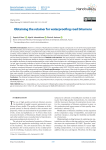
Obtaining the retainer for waterproofing road bitumens
Статья научная
Bitumen is a mixture of hydrocarbons and hetero-organic compounds. It is one of the most popular building materials today. Due to the growing consumption of bitumen for various purposes, the requirements for its quality characteristics are increasing, which prompts a comprehensive study of the physical and mechanical properties and methods of its modification. Currently, various additives are used, from inorganic materials to organic binders, including waste chemical, petrochemical and household industries. These additives create a nanodispersed structure inside the bitumen, which provides a change in the physical and mechanical properties in the required direction. Methods and materials. The work proposes a method for obtaining a fixer for waterproofing road bitumen based on nitrogen-containing organic compounds. The goal of research is to study the effect of the additive-derivative of triethylenediaminedicyan, which leads to the formation of a nanodispersed structure of bitumen of the “sol-gel” type, the quality indicators of which will meet the requirements of the new standard GOST 33133-2014 “Viscous road oil bitumen”. The object of the study is the bitumen production unit of workshop No. 14 of Gazprom neftekhimSalavat LLC, designed to produce commercial bitumen: oil road grades CB 90/130 in accordance with GOST 22245-90, used in road, civil and industrial construction as a binder and waterproofing material. Results and discussion. In the course of the study, the nature of the interaction and the effect of the modifier on the properties of bitumen, which ensure the production of nanostructured bitumen of the “sol-gel” type, were revealed. As a result of the study, a comparative assessment of the effect of the fixer on the properties of waterproofing bitumen revealed a significant improvement in physical and mechanical properties in comparison with bitumen grade CB 90/130. Conclusion. The obtained compound based on triethylenediaminedicyancan can be used as a fixing additive to road bitumen
Бесплатно
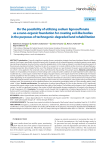
Статья научная
Introduction. Currently a significant number of quarry restoration strategies have been developed, based on different aspects of soil impact: specifically, mixing the topsoil with the empty rock of exhausted quarries; introducing organic waste; applying mulching and polymer structure formers; using the adapted plants. In this study we attempt to combine the positive aspects of the previously mentioned methods. Therefore, the aim of our research is to create artificial soil-like structures with specified agroecological properties. We anticipate further use of the obtained mixture as a layer between the quarry waste material and fertile soil, which is to be applied to the reclaimed surface and followed by the planting of local plant species. Materials and methods. Studies on the possibility of reclamation of mine tailings were conducted under conditions of model experiment with sodium lignosulfonate (SL), a waste organic material from the pulp and paper industry, as the organic base for the soil-like body. Fine fraction soil (FS) sampled from the mine tailings was mixed with SL in ratios of 1/0.5, 1/1, and 1/2; to accelerate the decomposition of organic matter depending on the experimental scheme, strains of bacteria Acinetobacter calcoaceticus and Pseudomonas kunmingensis were added. The obtained mixtures have been composting for three months at a room temperature, with regular mixing and maintaining moisture levels. The phytotoxicity of the obtained mixtures was assessed by germinating seeds of a short duration radish variety called "18 days". Results and discussion. The application of sodium lignosulfonate (SL) into the fine fraction soil (FS) significantly increased the organic matter content and decreased the acidity of the medium. The fertilizing with nitrogen in the SL experimental variants has led to a significant increase in the content of alkali-hydrolysable nitrogen compared to the variants in the absence of N and the presence of SL. Conclusion. The research results showed that the application of sodium lignosulfonate (SL) to the fine fraction soil (FS) contributed to a decrease in acidity, an increase in organic matter and alkali-hydrolysable nitrogen content in the mixture, as well as a reduction in substrate toxicity.
Бесплатно
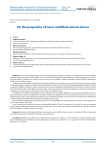
On the properties of nano-modified cement stones
Статья научная
The use of nanotechnology in the construction industry improves its efficiency. The application of nano-modified materials makes it possible to reduce capital costs. Currently the introduction of nanomaterials is of great importance for the construction industry. Carbonaceous structures can be used as nano-modifiers. Carbon nanotubular material TUBALL produced by OCSiAl.ru LLC has been chosen. To perform research samples of single-layer and multi-walled carbon nanotubes were used as a part of cement heavy concrete. The optimal dosage of carbon nanotubes in the composition of cement concrete has been experimentally determined. The studies revealed that addition of TUBALL carbon nanotubes to the cement composition contributed to the formation of a mesh structure that resists the formation of shrinkable nanoscale cracks in the cement mortar, promotes the appearance of calcium hydrosilicates, increases the concentration of calcium ions at the start of the hydration period. The influence of modified nanoadditives in the composition of the complex additive on the mechanical properties of the cement composition has been considered. The complex of mechanical properties of cement nanoreinforced stone in the process of cementing the annular space of producing wells by X-ray and thermal methods of analysis has been studied. That confirmed the results of experiments performed with electronic and optical microscopy. The microstructural elements of the cement specimen were investigated with high-resolution auto-emission scanning electron microscope Merlin by CARL ZEISS. It was found that the addition of complex nanomodified additive TUBALL accelerates the curing of the cement composite at early stage of hardening, decreases value of shrinkable nano-cracks, that in turn positively characterizes the quality of contacts at the boundaries of cement-casing, rock-cement.
Бесплатно
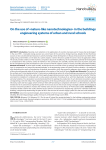
Статья научная
Introduction. Recently, much attention in the publications of scientists has been paid to “nature-like technologies” in the use of RES – renewable energy sources (sun, wind, heat). At the same time, foreign business, despite the fact that these sources are low concentrated and seasonal, is actively investing in their development. In Russia, these processes have been developing slowly, and therefore, on the basis of a system analysis, it seems relevant to justify the correct vector of application of RES. The article provides evidence of the insolvency of opinions about the insufficiency of the assimilation potential of the biosphere to compensate for the economic activity of mankind. In this connection, the scientific, technical and socio-economic tasks arise for the “reengineering of the technosphere” in the structure of the life support systems of society, including educational facilities. Methods and models. To solve these scientific, technical and socio-economic issues, by analogy with individual residential buildings, it is proposed to use “nature-like nanotechnologies” in the engineering systems of schools, and for evaluation - the method of retro-forecasting the results of introduction of domestic innovations, which has proved its adequacy when solving the problems of fire and environmental safety of the technosphere in the regions of the South of Russia. Results and discussion. The results of the synthesis and “virtual implementation” of autonomous engineering systems for school buildings are presented, which allow for the decentralization of electricity, water and heat supply by generating resources (water, heat and electricity) using the “Shukhov wind-electric installations” combined with a vortex system extraction of moisture of air, with their duplication by hydro panels and solar batteries. The calculations have demonstrated that the putting into production of such domestic innovations and the «reengineering» with their help of the engineering systems of 40 thousand Russian schools will allow autonomization and proper electricity, water and heat supply, which will ensure their safe functioning in compliance with GOST 12.1.004. Moreover, after the introduction of an autonomous engineering system in the school, due to the annual savings in budget subsidies for “pedagogical services”, it becomes possible to increase the monthly salary of each school teacher by 30–40 thousand rubles. Conclusion. The conducted studies confirm the results obtained in the synthesis of autonomous engineering systems for individual residential buildings, unequivocally determining the place of RES in the structure of resource supply systems for cities and rural settlements.
Бесплатно
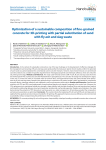
Статья научная
Introduction. In the context of sustainable construction, one of the key challenges is the development of effective strategies for the management and recycling of fly ash and slag waste produced by thermal power plants. Recent studies confirm the potential of such waste as a partial substitute for conventional sand in concrete mixtures. However, most research focuses on conventional concrete and does not consider the specific requirements for rheological properties and interlayer adhesion, which are critical for 3D printing technology. Methods and Materials. The study used Portland cement CEM I 42.5N, fly ash and slag waste from the Ust-Kamenogorsk TPP, crushed sand, and the MasterGlenium superplasticizer. The concrete mix design was developed in stages: a base mix, a control mix (with an increased water-to-cement ratio), and experimental mixes with 25% and 50% sand replacement by fly ash and slag waste. Samples were printed using a construction 3D printer (model S-6045) and tested for compressive strength, density, interlayer adhesion, and subjected to micro and nanostructural analysis. Results and Discussion. Experimental mixtures with 25% and 50% sand replacement showed reduced density and strength compared to the control mix. However, the 25% replacement mix maintained satisfactory strength, shape stability, and interlayer bonding. Micro and nanostructural analysis confirmed the relationship between structural compaction and physical-mechanical properties. Despite some limitations, the study demonstrated the potential of TPP-derived ash and slag waste as a viable component in 3D printing, provided the composition and extrusion parameters are optimized. Conclusion. The results indicate that replacing 25% of sand with fly ash and slag waste is optimal for fine-grained concrete mixtures intended for 3D printing. This approach improves resource efficiency and environmental sustainability without compromising the performance of the final products.
Бесплатно
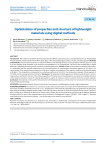
Optimization of properties and structure of lightweight materials using digital methods
Статья научная
Introduction. The solution to problems aimed at improving the efficiency of construction is closely linked to the use of lightweight mineral materials, which include mineral fibres, foam glass, cold-curing cellular glass, cellular concrete, and foam gypsum. Methods and materials. The aim of the research is to study the influence of technological factors on the properties of foam gypsum, as well as on the features of the formation of its structure and optimization of its compositions. The basis of the methodology is digital methods of planning, processing results, and their analytical optimization. Results. Based on the analysis of statistical information, it is established that the optimal composition is the one that includes the consumption of dihydrate gypsum of 76.6 kg/m3, the consumption of the polymerizing component of 9.8 kg/m3, and the consumption of the aqueous solution of the foaming agent of 80 kg/m3. This composition corresponds to a softening coefficient of 0.40–0.42; the compressive strength of foam gypsum is 0.75 MPa, and the average density is 320 kg/m3. Discussion. The properties of foam gypsum are determined by its macro- and microporosity, as well as the structure of the interpore partitions. The presence of connecting pores, as well as the crystalline structure of the interpore partition, makes the material permeable to vapour-air mixtures, which is a positive factor for acoustic materials. Conclusion. This material can be used for the production of individual products, as well as in low-rise construction of houses using frame-sheathing technology.
Бесплатно
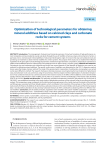
Статья научная
Introduction. The management of physical and chemical processes of structure formation of high performance cement composites can be provided at several scale levels through the use of modifiers of various nature and mechanism of action, in particular, micro- and nanoscale mineral additives of natural and technogenic origin. It is known that clays and carbonate rocks are promising raw materials to obtain mineral modifiers for cement systems. The purpose of this study was to establish the influence regularities of the prescription and technological parameters (material and granulometric compositions, temperature calcination) to obtain mineral additives based on calcined clays and carbonate rocks on their activity in cement systems. Methods and materials. Polymineral clays and carbonate rocks (dolomite and chalk) from several deposits of the Republic of Mordovia were used as raw materials for obtaining mineral additives. The specific surface area of modifiers was determined on the PSX-12 dispersion analysis device using the Kozeny-Carman method. The study of the granulometric composition of sedimentary rock powders was carried out by laser diffraction method. The research of physical-chemical processes occurring during the heat treatment of polymineral clays and carbonate rocks was carried out using the synchronous thermal analysis method. Optimization of calcination temperature of clay-carbonate mixtures was carried out based on the research results on the effect of their additives on the cement binder activity with the determination of the modifier activity index in accordance with the methodology of the Russian State Standard GOST R 56178-2014. Results and discussion. The optimum calcination temperature, located for polymineral clays in the area of 500–800оC, was established according to the study results of dehydration processes of clay minerals using the synchronous thermal analysis. This temperature range corresponds to the initial restructuring processes in the crystal structure of minerals of the kaolinite and illite groups, associated with their dehydroxylation, which contributes to the transition of these phases to the active form. The study results of influence of additives of calcined clay-carbonate mixtures on the cement binder activity proved the thermal analysis data. It was found that calcination of clays and clay-carbonate mixtures at 700°C contributes to obtaining of the most effective mineral modifiers. Conclusions. On the totality of studies, regularities were revealed in the system “modifier composition – calcination temperature of sedimentary rocks – mixed binder activity”, which allow optimizing the prescription and technological parameters for obtaining mineral additives to achieve the required level of strength characteristics of cement composites.
Бесплатно
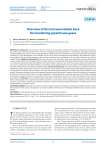
Overview of the instrumentation base for monitoring greenhouse gases
Статья научная
Introduction. The article describes the results of a comparative analysis of three large companies presenting on the market close control equipment for the control of climatically important parameters: LI-COR, Picarro and Gasera, and using nanotechnologies; the urgency of the ecological problem of finding a technical solution for the control of climatically active gases, including CO2 in the atmospheric air, was studied. The aim of the work is to analyze the world leaders in the production of precision equipment for monitoring greenhouse gases in the manufacture of nanomaterials and in scientific centers for the study of climate change. Methods and materials. The study is based on the information from open information sources, materials and reviews of various fields of knowledge made by scientific researchers, who describe the features of the activities of these companies or are directly involved in product development, and then compile a report on their work. The article contains information from true sources, namely from the official websites of companies, which describes their history of creation and development process. Research methods are benchmarking and SWOT analysis. Results and discussion. The study carried out a comparative analysis of companies in terms of the duration of work in world markets and its impact on the quality and technical features of products. The article provides information about companies that have achieved very good results from the beginning of their foundation to the present. The species diversity of old and new generation quality control devices sold in markets around the world by the companies in question is the same, which leads to very high competition. A description of the companies’ operations, their location, coverage of consumers is given, as well as the annual income from the sale of products, the amount of work that they do in the course of their activities. Conclusion. It was revealed that the companies LI-COR, Picarro, Gasera carry out the production of quality control devices that reproduce the required measurement parameters. Gas-analyzers of the companies are in demand in the market of precision control devices used to capture greenhouse gases in order to develop building nanomaterials, scientific research on the climate problems of modern society.
Бесплатно
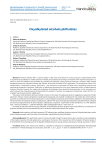
Oxyalkylated alcohols phthalates
Статья научная
Polyvinyl chloride (PVC) is used to obtain a wide range of materials for various purposes. High demand of PVC is explained by possibility to modify polyvinyl chloride and produce broad range of materials with improved properties as well as to have cost efficient ratio: productivity, available raw materials, saving of natural resources. However, under normal temperature polyvinyl chloride is brittle and inelastic, that limits the fields of PVC application. The production of basic PVC compositions is impossible without plasticizers – low-molecular compounds that allow direct regulating physical and mechanical properties of polymer. Production of plasticizers became one of the most important branch of petrochemical industry. Recently, however, the range and production of plasticizers have drastically decreased due to the increased cost, which reduced the competitiveness of plasticized PVC products. Therefore, the expansion of plasticizer variety for PVC is a strategic task of great practical significance. The present work describes synthesis methods of esters on the basis of oxyalkylated alcohols suggested as polyvinyl chloride plasticizers. Physico-chemical properties of synthesized compounds were studied. Conditions for their production with maximum outcome were selected. The results of experiments in which obtained compounds were tested as additives in the plasticization of PVC showed that the obtained samples of cable plastic, adhesive PVC tapes and multi-layered polyvinyl chloride linoleum satisfy all the technical requirements by the main indicators: cable plastic compound – GOST 5960-72 with amendment 1-9; a PVC adhesive tape – Technical Conditions – 2245-001-00203312-2003; multilayered linoleum – GOST 7251-77. According to the experimental results, phthalates of oxyalkylated alcohols possess rather high efficiency as plasticizers of polyvinyl chloride and are recommended for use in the above-mentioned industrial PVC recipes.
Бесплатно
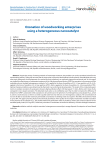
Ozonation of woodworking enterprises using a heterogeneous nanocatalyst
Статья научная
Despite the variety of existing methods of wastewater treatment, this problem can not be considered solved for the woodworking industry. Taking into account that the waste water of plywood-board plants includes phenols, formaldehyde and many other toxic substances, the development of a method for their treatment is an extremely important and actual task. In this regard, we studied the effectiveness of wastewater treatment of the Ufa plywood-board factory (UPBF) by ozonation in the presence of the available and most studied heterogeneous catalysts: Fe2O3, applied in the form of nanofilms of 0.5–1.0 mm particles γ-Al2O3; Al2O3, applied in the form of nanofilms 2.5–3.0 mm particles of TiO2; MnO2, applied in the form of nanofilms 2.5–3.0 mm particles of TiO2. Optimal cleaning conditions were determined by the kinetic curves of phenol decomposition. The results of the conducted experiments on catalytic ozonation of wastewater showed a high purification effect. COD decreased 1.7 (Al2O3, MnO2) and 3 times (Fe2O3) compared to non-catalyst ozonation. The obtained results allow us to confidently assert that in order to improve the efficiency of treatment of UPBF’s wastewater needs ozonation to be carried out in the presence of a heterogeneous nanocatalyst Fe2O3, which is used in a small amount, so there is no need to purify water from iron (III) ions as in homogeneous catalysis. The concentration of iron ion (III) did not exceed the maximum permissible concentration in drinking water (0.3 mg/dm3). The effect of treatment of COD is up to 96%. The paper presents physical and chemical parameters of the quality of the original wastewater and after ozonation in the presence of the catalyst Fe2O3. The studied method of purification makes it possible to reduce the content of phenol to the standard quality index (0.01 mg/dm3). Preliminary ozonation of wastewater increases the efficiency of further biological treatment.
Бесплатно

